An AI-Generated Protein Helps T Cells Kill Cancer

Artificial intelligence-generated “minibinder” protein enhanced T cell binding to and killing of cancer cells.
Image credit:Monica Fernandez-Quintero and Johannes Loeffler
Cancer immunotherapies widely rely on T cells. In order to become active, T cells interact via their receptors with the major histocompatibility complex (MHC), which expresses fragments of intracellular proteins, such as cancer antigens, on the cell surface. Scientists aim to enhance T cells’ interaction with cancer antigens but lack a high throughput approach to do so.
Sine Hadrup, an immunologist at the Technical University of Denmark, studies the interaction between T cells and cancer.
Sine Hadrup
To solve this problem, data scientist Timothy Jenkins and immunologist Sine Hadrup at the Technical University of Denmark used AI to design de novo T cell receptor (TCR)-like proteins that bind specifically to predetermined cancer antigens based on their known crystal structure in complex with MHC.1 In a recent Science study, Jenkins, Hadrup, and their colleagues discovered a designer protein, termed minibinder, that helped T cells kill cancer in vitro. Their discovery only took several weeks, in contrast to the typical one and a half years. The researchers also demonstrated that their platform could work for targets with unknown crystal structures.
“This is a very, very cool paper,” said Christopher Klebanoffan oncologist and immunobiologist at Memorial Sloan Kettering Cancer Center, who was not involved in the study. “Very, very cool application of generative (artificial intelligence) to solve a really, really challenging problem in the field.”
Christopher Klebanoff, an oncologist and immunobiologist at Memorial Sloan Kettering Cancer Center, researches T cell-based cancer immunotherapies. Klebanoff was not involved in the present study.
Christopher Klebanoff
As a proof of concept of their tool, the team used the platform to design a protein that could bind to NY-ESO-1, a cancer-associated antigen, and kill the cells that express it.2 Hadrup said that the team chose NY-ESO-1 as a target because the crystal structure of its complex with MHC has been solved. “We wanted to be sure that the target’s structure was not a limitation in the computational process,” she said.
The platform yielded several minibinders. “What generative AI came up with was fascinating to me because it looks nothing like what a T cell receptor normally looks like,” Klebanoff said. The next step was to verify if these structurally diverse minibinders could match T cell receptor function.
The researchers used AlphaFold2 to predict the MHC-binding characteristics of 44 minibinders, then validated their binding and specificity in vitro. They observed that one minibinder, which their computational models indicated as the most promising one, bound most strongly to MHC. Furthermore, cryoelectron microcopy of the crystal structure of the minibinder in complex with MHC showed a high overlap with the computational models. The team also observed that T cells that were engineered to express the minibinder on their surface killed NY-ESO-1-positive melanoma cells more effectively than their unmodified counterparts.
“What has been very encouraging is that what we have seen in the wet lab has correlated very well with the computational predictions that we have made,” Hadrup said.
Timothy Jenkins, a data scientist at the Technical University of Denmark, develops new de novo protein design-based approaches for translational research applications.
Timothy Jenkins
Next, the team tested their platform with an even more difficult task. They designed minibinders to target a metastatic melanoma neoantigen, whose MHC-bound crystal structure has not been solved. They ended up with a couple of proteins that bound strongly to the neoantigen in vitro.
“There was a lot of skepticism around de novo protein design, but the (2024) Nobel Prize has definitely woken a lot of people up in terms of how powerful this technology can be,” Jenkins said. “I think this is just the beginning of many cool applications of de novo protein design.”
“The driving vision here is to see something work in the clinic, not just designing something that’s academically interesting,” said Jenkins about their future plans.
Hadrup added that researchers can also develop these molecules as soluble binders to block the interaction between MHC and T cells in autoimmune diseases. “These other therapeutic areas are still not explored, and that’s something we would like to demonstrate in the future,” she said.



